A pioneer fashion and lifestyle magazine
- Margareth
- Aug 28, 2018
- 4 min read
Updated: Aug 24, 2020
It is funny what you can find in an old dusty box ...

On an ordinary day, during a hot summer holiday at my grandmother's house, I discovered an old wrinkled carton box inside the drawer of the modular cabinet. What I found in this box are some old fashion and lifestyle magazines from various decades, 1950s and 1960s mostly. Some of them are copies of fashion magazine Grazia from the years my mother was still a teenager and that she has always refused to throw away for she believes they are steeped in memories. Among the countless Twiggy, Jane Birkin and Patti Boyd covers from 1960s I picked up, with my great surprise, a 1928 copy of magazine Lidel. I could not believe my eyes when I first saw that!


I browsed the magazine and the themes. The old style advertising and the sophisticated fashion models I found inside took me back at that 1920s enchanting allure that always fascinates me.







I have never heard of this magazine before so I decided to learn more about it.
After the end of World War I, Europe went through a social, economic and political crisis of dramatic intensity. The newspapers and magazines had therefore required to address issues such as labour and industrial and economic reconstruction of the country after the war. Press was a mean for building up social cohesion and a new patriotism nationwide. This was the situation all over Europe, regardless of the single nations.
Since the magazine Lidel is Italian I am going to briefly analyse the situation in Italy during the 1920s.
Illiteracy rate in the “Bel Paese” drop significantly from 56% of year 1900 to 35,2% in 1920 and the cultural gap between wealth well educated upper classes and the working class sharpened. This was a great achievement for a nation whose population illiteracy rate was almost 80% in 1860. However, the gap between upper middle class and the lower middle class was still there when talking about quality. The so-called mass literature became more established among the middle-lower class, whose reference female model was that of the housewife devoted to take care of home and children. By this way, illustrated magazine with a strong circulation made their appearance and soon became the preferred reading.
Those magazines represented a natural evolution of this mass literature consumption and their aim was to build a nationwide mass culture, especially during Fascism.





Before Vogue was Lidel ...
If the illustrated periodic had a great success through the masses after the WWI, niche limited edition lifestyle magazines could also be found at the kiosks. They were more sumptuous and sophisticated and for that reason they were also much more expensive. The magazine which represented this niche category the most was the magazine Lidel.
Lidel was a fashion and lifestyle magazine found in Milan in 1919 by visionary and avant-garde journalist Lydia De Liguoro. Readings, Illustrations, drawings, elegance, job opportunities, fashion and other more challenging subjects were just few of the list of topics discussed in the pages of the magazine.
The magazine, printed on glossy paper, addressed to an elite of female audience by depicting an image of a sophisticated, feminine but yet strong woman that, over the years, aligned itself more and more with the fascist’s idea of female gender (as a woman as well as a mother). Lidel was a very patriotic magazine aiming to promote the “Made in Italy” label. CEO Lydia De Liguoro struggled to convince the Italian fashion industry to get rid of French fashion influence by encouraging the domestic industry to design their own models rather than producing clothes for the French market.
“It is not the first time in Italy that we discuss about the opportunity to create a national fashion industry, which can flourish in this land of aesthetes and artists, and be completely emancipated from the foreign servitude (referring to the French market). The claims that we deal with, however, concern the domestic industry in relationship to the awakening of a new feminine consciousness”.
— Her struggle for national claim led CEO Lydia de Liguoro to write an article herself on Lidel on August 1920
She thought that the creation of synergies between the Italian manufacturing industries and designers could lead to more attractive models to be exported to foreign markets. But this could not be implemented without first convincing customers to prefer Italian clothes rather than the French ones. The main aim of Lidel was therefore to convince its readers to buy Made in Italy.






The covers
1920 - 1929


1930 - 1935




Lidel laid the foundation for future fashion magazines that would have been created after the end of World War II. It was a true pioneer of lifestyle periodical. To make an example, Vogue Italy, the lifestyle magazine that more than others can be compared to Lidel in what concerns its topics, actually made its first appearance in 1962, that means 43 years after the first issue of Lidel in 1919.
Lidel last issue was publishe in 1935 and whenever I have a look at those glossy issues I am always enchanted by the elegance and allure of 1920s and 1930s fashion.
Thanks to Lidel and her founder Lydia De Liguoro, who struggled to create a national fashion industry, the “Ente Nazionale della Moda” (the National Board of Fashion), under the fascist directives, took an important decision for improving national production: 50 percent of the collection, made by Italian fashion designers, had to be Italian. This was such a relevant achievement that concerned not just fashion trade but the whole Italian industry, which got more conscious and payed more attention to the importance of manufacturing domestic goods rather than importing them from abroad. These were the basis for the creation of the common sense and label “Made in Italy”.


